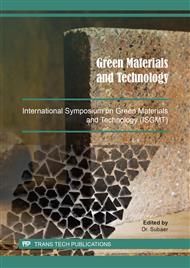p.59
p.65
p.71
p.83
p.95
p.101
p.107
p.113
p.118
Interaction of Physiology Character - Secondary Metabolic of Fusarium oxysporum on Tomatoes of Fusarium Wilt Symptom
Abstract:
Fusarium oxysporum (F. oxysporum) is the pathogen that caused fusarium wilt diseases on the tomatoes. The rise of the symptom was caused by secondary metabolic produced by F. oxysporum. The associated with the level of secondary metabolic pathogenesis that cause symptoms of wilt on tomatoes, but secondary metabolic excreted by F. oxysporum was not necessarily wilt in a plant. The phenomenon caused F. oxysporum producing secondary metabolic in the different concentration, either its quantity or quality. The nature of physiology being tested, observed by growing 4 isolates using a medium PDA on the temperature of 10, 15, 20, 25, 30, and 35 °C. The content of secondary metabolic measured on the four isolates using the Notz et al., (2002) and analyzed by using High-Performance Liquid Chromatography (HPLC). The results of the analysis of the nature of the physiological (colour colonies) were that every isolate planted for 8 days shows the variation of white, white redness, white yellowness until purpleness. Based on Methuen Handbook of Colour (Kornerup & Wanscher, 1978), generally isolates tested shows a bright colour, signaled with A letter at every code. Analysis HPLC on the results of secondary metabolic, either quantity or quality, sequentially were: isolates BAR (3; 1,997 ppm); ENR (3; 5,105 ppm); SID (4; 2,135 ppm) and MAL (5; 2,065 rpm). If it was seen by the relationship between the colour of colonies with the production of the secondary metabolic compound, it seemed that the older or darker colonies’ colour the more secondary compounds formed, but dark or old colonies’ colour does not determine a high quality of acid fusaric produced. Keywords: Colonies colour, F. oxysporum, secondary metabolic .
Info:
Periodical:
Pages:
95-100
Citation:
Online since:
August 2019
Authors:
Keywords:
Price:
Сopyright:
© 2019 Trans Tech Publications Ltd. All Rights Reserved
Share:
Citation:


